பிரிட்டன் சண்டை
பிரிட்டன் சண்டை (ஆங்கிலம்: Battle of Britain; ஜெர்மன்: Luftschlacht um England அல்லது Luftschlacht um Großbritannien) 1940ல் இரண்டாம் உலகப் போரின் மேற்குப் போர்முனையில் நிகழ்ந்த ஒரு சண்டை. நாசி ஜெர்மனியின் விமானப்படையான லுஃப்ட்வாஃபே பிரிட்டனின் விமானப்படையைத் தாக்கி அழிக்க மேற்கொண்ட முயற்சி “பிரிட்டன் சண்டை” என்றழைக்கப்படுகிறது. இப்பெயர் பிரிட்டிஷ் பிரதமர் வின்ஸ்டன் சர்ச்சில் பாராளுமன்றத்தில் ஆற்றிய ஒரு பேருரையிலிருந்து உருவானது. "பிரான்சுக்கான சண்டை முடிந்து விட்டது. அடுத்து பிரிட்டனுக்கான சண்டை ஆரம்பமாகும்” என்று அவர் பேசிய வார்த்தைகளே இச்சண்டையின் பெயர்காரணமாகின. ஜூலை-அக்டோபர், 1940 காலகட்டத்தில் பிரிட்டனின் வான்பிரதேசங்களில் நடைபெற்ற இச்சண்டை, முழுவதும் விமானப்படைகள் மட்டுமே மோதிய முதல் போராகக் கருதப்படுகிறது.
| பிரிட்டன் சண்டை | |||||||
|---|---|---|---|---|---|---|---|
| இரண்டாம் உலகப் போரின் பகுதி | |||||||
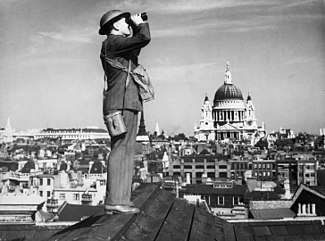 பிரிட்டனின் கண்காணிப்பாளர் கோரின் உறுப்பினர் ஒருவர் லண்டனின் வான்பிரதேசங்களைக் கண்காணிக்கிறார். |
|||||||
|
|||||||
| பிரிவினர் | |||||||
| தளபதிகள், தலைவர்கள் | |||||||
| பலம் | |||||||
| 1,963 பறக்கக் கூடிய விமானங்கள். [28] | 2,550 பறக்கக் கூடிய விமானங்கள். [30] | ||||||
| இழப்புகள் | |||||||
| 544 விமானப்படையினர் (மாண்டவர்)[5][32][33] 422 (காயமடைந்தவர்)[34] 1,547 விமானங்கள்[35] | 2,698 விமானப்படையினர் (மாண்டவர்)[36] 967 (கைப்பற்றப்பட்டவர்) 638 (காணாமல் போனவர்)[37] 1,887 விமானங்கள்[39] |
||||||
மேற்கு ஐரோப்பா முழுவதையும் கைப்பற்றிய பின் நாசி ஜெர்மனியின் படைகள் அடுத்து பிரிட்டன் தீவுகளைக் கைப்பற்றத் திட்டமிட்டன. ஆங்கிலக் கால்வாயைக் கடந்து பிரிட்டனின் கடற்கரைகளில் படைகளைத் தரையிறக்க பிரிட்டிஷ் விமானப்படை பேரிடராக இருக்கும் என்பதால், தரைவழி படையெடுப்பு தொடங்கும் முன் அதை அழிக்க வேண்டும் என்பதற்காக ஹிட்லரும், லுஃப்ட்வாஃபே தலைமைத் தளபதி கோரிங்கும் வான்வழித் தாக்குதலைத் தொடங்கினர். ஆரம்பத்தில் இதன் இலக்கு பிரிட்டன் விமானப்படையின் அழிவாக மட்டும் இருந்தது. ஆனால் சண்டையின் இடையில் ஹிட்லர் பிரிட்டனின் நகரங்களின் மீது குண்டு வீசி அழிக்க உத்தரவிட்டார். இவ்வாறு மாறுபட்ட இலக்குகளை லுஃப்ட்வாஃபேவால் நிறைவேற்ற முடியாமல் ஜெர்மனியின் தாக்குதல் தோல்வியடைந்தது. லுஃப்ட்வாஃபே விமானங்களின் இழப்புகள் மிகவும் அதிகமானதால் ஜெர்மனி வான்வழித் தாக்குதலை நிறுத்திக்கொண்டது. பிரிட்டன் மீது படையெடுக்க வகுக்கப்படிருந்த சீ லயன் நடவடிக்கைத் திட்டமும் கைவிடப்பட்டது. இரண்டாம் உலகப்போரில் ஜெர்மனி சந்தித்த முதல் தோல்வி இதுவே.
பின்புலம்
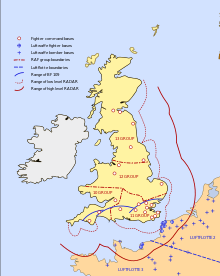
1940ல் நாசி ஜெர்மனியின் படைகள் மேற்கு ஐரோப்பாவின் பெரும்பகுதியைக் கைப்பற்றி விட்டன. பெல்ஜியம், நெதர்லாந்து, டென்மார்க், நார்வே போன்ற நாடுகள் நாசிப் போர் எந்திரத்தின் வலிமையின் முன்னால் ஈடுகொடுக்க முடியாமல் ஒன்றன்பின் ஒன்றாக சரணடைந்தன. ஜூன் 1940ல் பிரான்சு சண்டை முடிந்து பிரான்சும் ஜெர்மனியிடம் சரணடைந்தது. மேற்கு ஐரோப்பாவில் நாசிகளுக்கு மீதமிருந்த ஒரே எதிரி பிரிட்டன் மட்டுமே. பிரிட்டனின் படை பிரான்சு போர்க்களத்தில் படுதோல்வியடைந்து ஜெர்மனி படைகளால் சிறைபிடிக்கப் படுவதிலிருந்து மையிரிழையில் தான் தப்பியிருந்தன. வீரர்கள் தப்பினாலும், பிரிட்டனின் பீரங்கிகள், டாங்குகள், தளவாடங்கள் ஆகியவற்றில் மிகப்பெரும்பகுதி ஜெர்மன் படையின் கையில் சிக்கிக் கொண்டது. இதனால் மனமுடைந்த பிரிட்டன் விரைவில் அமைதி கோரி பேச்சுவார்த்தைக்கு இணங்கிவிடும் என்று ஹிட்லர் நம்பினார். சோவியத் யூனியன் மீது உடனே படையெடுக்க வேண்டுமென்று அவசரப்பட்டார். ஆனால் பிரிட்டனில் பிரதமர் நெவில் சாம்பர்லேனின் ஆட்சி கவிழ்ந்து வின்ஸ்டன் சர்ச்சில் பிரதமரானதால், அந்நாடு சமாதானப் பேச்சுக்கு வரமறுத்து விட்டது. இதனால் பிரிட்டன் மீதான படையெடுப்பு பற்றி ஜெர்மன் போர்த் தலைமையகம் திட்டமிடத் தொடங்கியது.
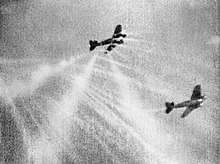
பிரிட்டனைத் தாக்க எத்தனிக்கும் எந்தவொரு தரைப்படையும் அதனை ஐரோப்பிய நிலப்பரப்பிலிருந்து பிரிக்கும் ஆங்கிலக் கால்வாயைக் கடந்தே செல்ல வேண்டும். வலிமை வாய்ந்த பிரிட்டன் கடற்படை ஆங்கிலக் கால்வாயைப் பாதுகாத்து வந்ததால் ஜெர்மனி தரைப்படை தளபதிகள் படையெடுப்பினால் பெரும் இழப்புகள் உண்டாகுமென்று ஹிட்லரை எச்சரித்தனர். ஜெர்மனியின் கடற்படை தளபதி அட்மைரல் எரிக் ரைடர் இதற்கு முன்னால் நார்வே நாட்டின் மீது படையெடுத்த போது தமது படை பெரும் சேதமடைந்து விட்டதாகவும், பிரிட்டனின் கடற்படையைச் சமாளிக்கும் பலம் அதற்கு இல்லையெனவும் எச்சரித்தார். இதனால் ஜெர்மன் தரைப்படைகள் பிரிட்டன் கடற்படையின் தாக்குதலுக்குள்ளாகாமல் ஆங்கிலக் கால்வாயைக் கடக்க ஜெர்மன் விமானப்படையின் (லுஃப்ட்வாஃபே) குதி குண்டுவீசி விமானங்களின் (டைவ் பாம்பர்கள்) துணை வேண்டுமென்பது புலனானது. இது நடக்கவேண்டுமெனில் முதலில் பிரிட்டனின் விமானப்படை அழிக்கப்பட வேண்டும். ஏனென்றால் ஜெர்மன் குண்டுவீசி விமானங்களை அதனைவிட வேகமாகச் செல்லக் கூடிய பிரிட்டிஷ் சண்டை விமானங்கள் (ஃபைட்டர்ஸ்) எளிதில் சுட்டு வீழ்த்திவிடும். இந்த சூழலை கருத்தில் கொண்டு ஜூலை 16, 1940ல் ஹிட்லர் தனது 16வது ஆணையைப் பிறப்பித்தார்: பிரிட்டன் மீது படையெடுக்க வேண்டும்; அப்படையெடுப்பு நிகழும் போது ஆங்கிலக் கால்வாயில் பிரிட்டிஷ் விமானப்படையால் இடையூறு ஏற்படக்கூடாது. எனவே படையெடுப்பு நிகழும் முன் பிரிட்டிஷ் விமானப்படை நொறுக்கப்பட வேண்டும். ஆங்கிலக் கால்வாயின் வான்பிரதேசங்களில் லுஃப்ட்வாஃபே ஆதிக்கம் செலுத்த வேண்டும். இந்த வான் ஆதிக்க நிலையை அடைவதற்கு கொரிங்கின் லுஃப்ட்வாஃபேவிற்கு ஆகஸ்ட் மத்திவரை அவகாசம் தரப்பட்டது.
நிகழ்வுகள்
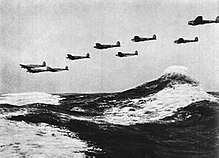
லுஃப்ட்வாஃபே ஜூலை மாதம் பிரிட்டிஷ் விமானப்படையின் மீது தனது தாக்குத்லைத் தொடங்கியது. அடுத்த மூன்று மாதங்கள் இடைவிடாது நடைபெற்ற இச்சண்டையை நான்கு முக்கிய கட்டங்களாகப் பிரிக்கலாம்:
- ஜுலை 10 - ஆகஸ்ட் 11 : கால்வாய் மோதல்கள்
- ஆகஸ்ட் 12 - ஆகஸ்ட் 23: “கழுகுத் தாக்குதல்” கரையோர விமானத்தளங்களின் மீதான லுஃப்ட்வாஃபே தாக்குதல்கள்
- ஆகஸ்ட் 24 - செப்டம்பர் 6 : பிரிட்டிஷ் விமானப்படைத் தளங்களின் மீதான் உச்சகட்ட தாக்குதல்கள்
- செப்டம்பர் 6 முதல் : பிரிட்டனின் நகரங்கள் மற்றும் குடியிருப்புகள் மீதான தாக்குதல்கள்
ஆரம்பத்தில் லுஃப்ட்வாஃபே ஆங்கிலக்கால்வாய் மீது சரக்குக் கப்பல்கூட்டங்களின் மீது தாக்குதல் தொடுத்தன. தங்கள் விமானங்கள் மற்றும் விமானிகளின் பலங்களையும் பலவீனங்களையும், பிரிட்டனனின் பாதுகாப்பு ஏற்பாடுகளையும் அறிந்து கொள்ள ஜெர்மன் தளபதிகள் ஸ்பெர்லேயும் கெச்சல்ரிங்கும் இத்தாக்குதல்களைப் பயன்படுத்திக்கொண்டனர். இத்தாக்குதல்கள் லுஃப்ட்வாஃபேக்கு பெரும் வெற்றியில் முடிவடைந்தன. சரக்குக் கப்பல்களின் இழப்புகள் அளவுக்கதிகமானதால் பிரிட்டன் ஆங்கிலக் கால்வாயில் சரக்குக் கப்பல்கூட்டங்கள் செல்வதை தடை செய்துவிட்டது. இந்த மோதல்கள் இரு தரப்பினரும் எதிரிகளின் உத்திகளைத் தெரிந்து கொள்ள உதவின.
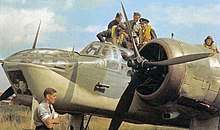
கால்வாய் மோதல்களில் அடைந்த வெற்றியைத் தொடர்ந்து லுஃப்ட்வாஃபே கரையோர பிரிட்டிஷ் விமானப்படைத் தளங்களை குறிவைக்கத் தொடங்கியது. அட்லரான்கிர்ஃப் (கழுகுத் தாக்குதல்) என்று சங்கேதப்பெயரிடப்பட்ட இத்தாக்குதல் ஆகஸ்ட் 13ம் தேதி தொடங்கியது. ராடார் நிலையங்கள், கரையோர ஓடுதளங்கள் ஆகியவை குண்டுவீசி தகர்க்கப்பட்டன. ஆகஸ்ட் 24 வரை நடைபெற்ற இத்தாக்குதல்களில் இருதரப்பிலும் பெருத்த சேதம் ஏற்பட்டது. யாருக்கும் வெற்றி ஏற்படாத நிலையில் கோரிங் தனது படையினருக்கு வேறொரு உத்தரவைப் பிறப்பித்தார்.
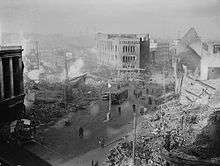
ஆக்ஸ்ட் 24ல் கோரிங்கின் உத்தரவின்படி லுஃப்ட்வாஃபே உள்நாட்டிலுள்ள பிரிட்டிஷ் விமானத்தளங்களை, விமானங்களுக்கு உதிரி பாகங்களைத் தயாரிக்கும் தொழிற்சாலைகளையும் தாக்கத் தொடங்கின. அடுத்த இருவாரங்கள் பிரிட்டன் சண்டையின் அதிமுக்கிய கட்டமாகக் கருதப்படுகிறது. இரு புறமும் பெருத்த சேதம் ஏற்பட்டு, படைகள் சோர்வடையத் தொடங்கின. இருப்பினும் சண்டையின் உக்கிரம் மேலும் தீவிரமடைந்தது. அதுவரை ஹிட்லரின் நேரடி உத்தரவின்படி பிரிட்டனின் மக்கள் குடியிருப்புகள் மீது குண்டு வீசுவதை லுஃப்ட்வாஃபே விமானிகள் தவிர்த்து வந்தனர். ஆனால் தவறுதலாக லண்டனின் சுற்றுப்புறங்களில் இருந்த சில விமானதளங்களின் மீது குண்டுகள் வீசப்பட்டன. இதற்குப் பதிலடி கொடுப்பதற்காக சர்ச்சில் ஜெர்மனியின் தலைநகரம் பெர்லின் மீது குண்டு வீச ஆணையிட்டார். இதனால் கோபமடைந்த ஹிட்லர் தனது முந்தைய ஆணையை விலக்கிக் கொண்டார். பிரிட்டனின் நகரங்களை தரைமட்டமாக்கும்படி கோரிங்க்கு உத்தரவிட்டார். இதனால், ஜெர்மனியின் போர் இலக்கு பிரிட்டனின் விமானப்படையை அழிப்பதிலிருந்து பிரிட்டனின் நகரங்களை அழிப்பதற்கு மாற்றப்பட்டது. இம்மாற்றம், பிரிட்டிஷ் விமானப்படைக்குச் சாதகமாகிப் போனது. செப்டம்பர் மாதம் முழுவதும் லண்டன் முதலிய பிரிட்டிஷ் நகரங்கள் கடுமையான குண்டுவீச்சுக்கு உள்ளாகின. ஆனால் பிரிட்டிஷ் விமானத்தளங்கள் தாக்குதலிருந்து தப்பித்தன. இது எதிர்த் தாக்குதல் நிகழ்த்த பிரிட்டிஷ் விமானப்படைக்குப் பெரிதும் உதவியது. தாக்குதலில் ஈடுபட்ட லுஃட்ஃபுளோட்டுகளுக்கு (ஜெர்மன் விமானப்படைப் பிரிவுகள்) பேரிழப்பு ஏற்பட்டது. பிரிட்டன் சரணடையவும் இல்லை, அதன் விமானப்படைக்குப் பெரும் அழிவு ஏற்படவும் இல்லை. தோல்வியை ஒப்புக்கொண்ட ஹிட்லர் அக்டோபர் 13ல் சீ லயன் நடவடிக்கையை அடுத்த ஆண்டுக்கு ஒத்திவைத்தார். இத்துடன் பிரிட்டன் சண்டை நிறைவுக்கு வந்தது.
விளைவுகள்

லுஃப்ட்வாஃபேவினால் பிரிட்டனின் வான்வெளியில் வானாதிக்க நிலையை அடைய முடியாததால், திட்டமிடப்பட்டிருந்த ஜெர்மனியின் பிரிட்டன் படையெடுப்பு கைவிடப்பட்டது. நாசி போர் எந்திரத்தை எதிர்த்து ஒரு நாடு தப்பிப் பிழைக்கமுடியுமென்பதை பிரிட்டனின் இந்த வெற்றி உலகுக்கு உணர்த்தியது. இவ்வெற்றிக்குப் பின்னர், பிரிட்டனுக்கு உதவுவது பற்றியான அமெரிக்காவின் நிலை பிரிட்டனுக்குச் சாதகமாக மாறியது. மேற்குப் போர்முனையில் இன்னும் ஒரு எதிரி மீதமிருக்கும்போதே கிழக்குப் போர்முனை நோக்கி ஹிட்லர் தன் கவனத்தைத் திசை திருப்ப வேண்டியதாயிற்று. இதனால் அடுத்த நான்காண்டுகள் சோவியத் யூனியனுடனான போரில் அவரால் ஜெர்மனியின் முழுபலத்தை பிரயோகிக்க முடியவில்லை. பிரிட்டனைத் தளமாக பயன்படுத்திக் கொண்ட நேச நாடுகள் ஜெர்மனியின் ஆக்கிரமிப்பிலிருந்த ஐரோப்பா மீது அவ்வப்போது தாக்குதல் நடத்தி தொல்லை கொடுத்து வந்தன. 1944ல் பிரான்சு மீது நேச நாடுகள் படையெடுக்கவும் பிரிட்டன் தளமாக உதவியது. இதனால் இருமுனைகளிலும் போரிடும் நிலைக்கு ஜெர்மனி தள்ளப்பட்டது. எனவே பிரிட்டன் சண்டையில் ஜெர்மனியின் தோல்வி பெரும் போரியல் உபாயத் தவறாகக் கருதப்படுகிறது.
பிரிட்டன் சண்டையில் லுஃப்ட்வாஃபேவைத் தோற்கடித்த பிரிட்டிஷ் விமானிகள் பிரிட்டன் ஆட்சியாளர்களாலும், மக்களாலும் பெருமளவில் கொண்டாடப்படுகின்றனர். சர்ச்சில் நாடாளுமன்றத்துக்கு ஆற்றிய உரையொன்றில் ”நமது வரலாற்றில் இதற்கு முன்னர் இதுபோல இத்தனை மக்கள், ஒரு சிலருக்கு (விமானிகள்) கடமைப்பட்டிருக்கும் நிலை இருந்ததில்லை” என்று அவர்களைப் பாராட்டினார். அன்று முதல் பிரிட்டன் சண்டையில் ஈடுபட்ட பிரிட்டிஷ் விமானிகள் “அந்த ஒரு சிலர்” (The Few) என்று பெருமையுடன் அழைக்கப்படுகின்றனர். ஆண்டுதோறும் செப்டம்பர் 15ம் நாள் பிரிட்டனில் “பிரிட்டன் சண்டை தினமாக” அனுசரிக்கப்படுகிறது.
அடிக்குறிப்புகள்
- Note: The British date the battle from 10 July to 31 October 1940, which represented the most intense period of daylight bombing. Foreman 1988, p. 8. German historians usually place the beginning of the battle in mid-August 1940 and end it in May 1941, with the withdrawal of the bomber units in preparation for Operation Barbarossa, the campaign against the Soviet Union, which began on 22 June 1941. Foreman 1988, p. 8
- Terraine 1985, p. 219.
- Quoting Luftwaffe General Werner Kreipe: Terraine states the outcome as "decisive", Kreipe describes it as a strategic failure and turning point in the Second World War. Kreipe also states the "German Air Force was bled almost to death, and suffered losses that could never be made good throughout the course of the war". Quoting Dr Klee "The invasion and subjugation of Britain was made to depend on that battle, and its outcome therefore materially influenced the further course and fate of the war as a whole".[2]
- Shulman 2004, p. 63.
- Bungay p. 368.
- Fighter Command's victory was decisive. Not only had it survived, it ended the battle stronger than it had ever been. On 6 July its operational strength stood at 1,259 pilots. On 2 November, the figure was 1,796, an increase of over 40%. It had also seriously mauled its assailant. In a lecture held in Berlin on 2 February 1944, the intelligence officer of KG 2, Hauptmann Otto Bechle, showed that from August to December 1940 German fighter strength declined by 30% and bomber strength by 25%.[5]
- Hough and Richards 2007, p. xv.
- "The Battle was one of the great turning points in the Second World War—a defensive victory which saved the Island base and so, once Russia and the United States became involved, made future offensive victories possible."[7]
- Overy 2001, p. 267 in Addison and Crang's The Burning Blue quotes A.J.P Taylor "a true air war, even if on a small scale and had decisive strategic results".
- Deighton 1980, p. 213.
- Keegan 1997, p. 81.
- "As it was, the pragmatism of Dowding and his Fighter Command staff, the self-sacrifice of their pilots and the innovation of radar inflicted on Nazi Germany its first defeat. The legacy of that defeat would be long delayed in its effects; but the survival of an independent Britain which it assured was the event that most certainly determined the downfall of Hitler's Germany."[11]
- Buell 2002, p. 83.
- "Given the ambiguous results of subsequent air campaigns against Germany. Japan, North Korea, and North Vietnam, it is probably fair to say that the Battle of Britain was the single most decisive air campaign in history."[13]
- Terraine 1985, p. 181.
- Shirer 1991, p. 769.
- AJP Taylor 1974, p. 67.
- "A decisive battle has been defined as one in which a 'contrary event would have essentially varied the drama of the world in all its subsequent stages'. By this reckoning, the Battle of Britain was certainly decisive."[17]
- Bungay 2000, p. 386.
- Bungay quoting Drew Middleton in The Sky Suspended: In 1945 the Soviets asked Gerd von Rundstedt which battle of the war he considered to be most decisive. Expecting him to say "Stalingrad", he said "The Battle of Britain". The Soviets left immediately.[19]
- Peszke 1980, p. 134.
- The RAF was the only sovereign Allied air force; the Polish Air Force was not given sovereignty until June 1944[21]
- "World War II: The RCAF Overseas." airforce.forces.gc.ca, 3 April 2009. Retrieved: 6 February 2010.
- "No 1 (R.C.A.F.) Hurricane Squadron." the-battle-of-britain.co.uk. Retrieved: 6 February 2010.
- 1 RCAF Squadron was not formed under Article XV because the unit was formed in Canada in 1937. When it was sent to Britain in 1940, it was manned by RCAF (including some American) officers, paid at Canadian pay rates, and its Canadian built Hurricanes were supplied by the Canadian government. In effect 1 RCAF Sqn. was a sovereign Canadian unit under the operational control of the RAF.[23][24] By contrast the Polish and Czech manned squadrons were formed as RAF units and fell completely within the RAF's administrative and operational structure.
- Rino Corso Fougier
- Bungay 2000, p. 107.
- 754 ஒரிருக்கை சண்டை விமானங்கள், 149 ஈரிருக்கை சண்டை விமானங்கள், 560 குண்டு வீசிகள் 500 கரையோர ரோந்து விமானங்கள். The RAF fighter strength given is for 0900 1 July 1940, while bomber strength is for 11 July 1940.[27]
- Wood and Dempster 2003, p. 318.
- Figures taken from Quartermaster General 6th Battalion returns on 10 August 1940. According to these, the Luftwaffe deployed 3,358 aircraft against Britain, of which 2,550 were serviceable. The force was made up by 934 single-seat fighters, 289 two-seat fighters, 1,481 medium bombers, 327 dive-bombers, 195 reconnaissance and 93 coastal aircraft, including unserviceable aircraft. The number of serviceable aircraft amounted to 805 single-seat fighters, 224 two-seat fighters, 998 medium bombers, 261 dive-bombers, 151 reconnaissance and 80 coastal aircraft.[29]
- The Luftwaffe possessed 4,074 aircraft, but not all of these were deployed against Britain. The force was made up of 1,107 single-seat fighters, 357 two-seat fighters, 1,380 medium bombers, 428 dive-bombers, 569 reconnaissance and 233 coastal aircraft, including unserviceable aircraft. The Luftwaffe air strength given is from the Quartermaster General 6th Battalion numbers for 29 June 1940.[27]
- Ramsay 1989, pp. 251–297.
- "Battle of Britain RAF and FAA role of honour." raf.mod.uk. Retrieved: 14 July 2008
- Wood and Dempster 2003, p. 309.
- 1,023 fighters, 376 bombers and 148 aircraft from Coastal Command.
- Bungay 2000, p. 373.
- Bodies identified by British authorities.Overy 2001, p. 113.
- 873 fighters and 1,014 bombers destroyed.[38]
சான்றுகள்
பொது
- Allen, Hubert Raymond "Dizzy", Wing Commander, RAF. Who Won the Battle of Britain? London: Arthur Barker, 1974. ISBN 0-213-16489-2.
- Buckley, John. Air Power in the Age of Total War. London: UCL Press, 1999. ISBN 1-85728-589-1.
- Buell, Thomas. The Second World War: Europe and the Mediterranean. New York: Square One Publishers, 2002. ISBN 978-0-7570-0160-4.
- Bungay, Stephen. The Most Dangerous Enemy: A History of the Battle of Britain. London: Aurum Press, 2000. ISBN 1-85410-721-6 (hardcover), 2002, ISBN 1-85410-801-8 (paperback).
- Churchill, Winston S. The Second World War – Their Finest Hour (Volume 2). London: Cassell, 1949.
- Deighton, Len. Fighter: The True Story of the Battle of Britain. London: Pimlico, 1996. (Originally published: London: Jonathan Cape, 1977.) ISBN 0-7126-7423-3.
- Deighton, Len. Battle of Britain. London: Cape, 1980. ISBN 0-224-01826-4.
- de Zeng, Henry L., Doug G. Stankey and Eddie J. Creek. Bomber Units of the Luftwaffe 1933-1945: A Reference Source, Volume 1. Hersham, Surrey, UK: Ian Allen Publishing, 2007. ISBN 978-1-85780-279-5.
- Dönitz, Karl. Ten years and Twenty Days. New York: Da Capo Press, First Edition, 1997. ISBN 0-306-80764-5.
- Dye, Air Commodore Peter J. "Logistics and the Battle of Britain". Air Force Journal of Logistics No. 24, Vol 4, Winter 2000.
- Ellis, John. Brute Force: Allied Strategy and Tactics in the Second World War. London: Andre Deutsch, 1990. ISBN 0-8264-8031-4.
- Evans, Michael. "Never in the field of human conflict was so much owed by so many to... the Navy." The Times, 24 August 2006. Retrieved: 3 March 2007.
- Halpenny, Bruce Barrymore. Action Station 4: Military Airfields of Yorkshire. Cambridge, UK: Patrick Stevens, 1984. ISBN 0-85059-532-0.
- Harding, Thomas. "Battle of Britain was won at sea." The Telegraph, 25 August 2006. Retrieved: 25 August 2006.
- Holland, James. The Battle of Britain. London: Bantam, 2010. ISBN 978-0-593-05913-5.
- Hooton, E.R. Luftwaffe at War; Blitzkrieg in the West: Vol. 2, London: Chevron/Ian Allen, 2007. ISBN 978-1-85780-272-6.
- Hough, Richard and Denis Richards. The Battle of Britain: The Greatest Air Battle of World War II. New York: W.W. Norton & Co Inc, 2007. ISBN 978-0-393-02766-2.
- Irving, David. The Rise and Fall of the Luftwaffe: The Life of Field Marshal Erhard Milch. Dorney, Windsor, UK: Focal Point Publications, 1974. ISBN 978-0-297-76532-5.
- Keegan, John. The Second World War London: Pimlico, 1997. ISBN 978-0-7126-7348-8.
- Kieser, Egbert. Operation Sea Lion; The German Plan to Invade Britain 1940. London: Cassel Military Paperbacks, 1999. ISBN 0-304-35208-X.
- Kieser, Egbert. Unternehmen Seelöwe: Die geplante Invasion in England 1940 (in German). Berlin, Germany: Becthle, 2000. ISBN 3-7628-0457-5.
- Korda, Michael. With Wings Like Eagles: The Untold Story of the Battle of Britain. New York: Harper Perennial, 2010. ISBN 978-0-06-112536-2.
- Macksey, Kenneth. Invasion: The German Invasion of England, July 1940. London: Greenhill Books, 1990. ISBN 0-85368-324-7.
- Murray, Willamson. Strategy for Defeat. The Luftwaffe 1935-1945. Princeton, New Jersey: University Press of the Pacific, 2002. ISBN 0-89875-797-5.
- Overy, Richard. The Battle of Britain: The Myth and the Reality. New York: W.W. Norton, 2001. ISBN 0-393-02008-8 (hardcover); 2002, ISBN 0-393-32297-1(paperback).
- Peszke, Michael Alfred. "A Synopsis of Polish-Allied Military Agreements During World War Two." The Journal of Military History , Volume 44, No. 3, October 1980, pp. 128–134.
- Ponting, Clive. 1940: Myth and reality. Chicago: Ivan R. Dee, 1991. ISBN 978-1-56663-036-8.
- Pope, Stephan. "Across the Ether: Part One". Aeroplane, Vol. 23, No. 5, Issue No. 265, May 1995.
- Price, Alfred. The Hardest Day: 18 August 1940. New York: Charles Scribner's Sons, 1980. ISBN 0-684-16503-1.
- Ramsay, Winston, ed. The Blitz Then and Now: Volume 1. London: Battle of Britain Prints International Ltd, 1987. ISBN 0-900913-45-2.
- Raeder, Erich. Erich Rader, Grand Admiral. New York: Da Capo Press. United States Naval Institute, 2001. ISBN 0-306-80962-1.
- Ramsay, Winston, ed. The Blitz Then and Now: Volume 2. London: Battle of Britain Prints International Ltd, 1988. ISBN 0-900913-54-1.
- Ramsay, Winston, ed. The Battle of Britain Then and Now Mk V. London: Battle of Britain Prints International Ltd, 1989. ISBN 0-900913-46-0.
- Ray, John. Britain Alone: WW II. London: The Orion Publishing Co., 2003. ISBN
- Robinson, Derek. Invasion, 1940: Did the Battle of Britain Alone Stop Hitler? New York: Carroll & Graf, 2005. ISBN 0-7867-1618-5.
- Shulman, Milton. Defeat in the West. London: Cassell, 2004 (First edition 1947). ISBN 0-304-36603-X.
- Shirer, William. The Rise and Fall of the Third Reich: A History of Nazi Germany. London: Ballantine, 1991. ISBN 978-0-449-21977-5.
- Taylor, A.J.P. and S.L. Mayer, eds. A History Of World War Two. London: Octopus Books, 1974. ISBN 0-7064-0399-1.
- Terraine, John. The Right of the Line: The Royal Air Force in the European War, 1939-1945. New York: Sceptre, 1985. ISBN 0-340-41919-9.
- Terraine, John. A Time for Courage: The Royal Air Force in the European War, 1939-1945. London: Macmillan, 1985. ISBN 978-0-02-616970-7.
- Winterbotham, F.W. The Ultra Secret. London: Futura Publications Limited, 1975. ISBN 0-86007-268-1 (paperback).
- Wood, Derek and Derek Dempster. The Narrow Margin: The Battle of Britain and the Rise of Air Power. London: Tri-Service Press, third revised edition, 1990. ISBN 1-85488-027-6.
- Zaloga, Steven J. and Richard Hook. The Polish Army 1939-45. London: Osprey, 1982. ISBN 0-85045-417-4.
வாழ்க்கை வரலாறுகள்
- Deere, Alan C. Nine Lives. London: Hodder Paperbacks Ltd for Coronet Books, 1974. ISBN 0-340-01441-5.
- Duncan Smith, Group Captain W.G.G. . Spitfire into Battle. London: John Murray, 2002. ISBN 0-7195-5484-5.
- Franks, Norman. Wings of Freedom: Twelve Battle of Britain Pilots. London: William Kimber, 1980. ISBN 0-7183-0197-8.
- Galland, Adolf. The First and the Last: Germany's Fighter Force in WWII (Fortunes of War). South Miami, Florida: Cerberus Press, 2005. ISBN 1-84145-020-0.
- Halpenny, Bruce Barrymore. Fight for the Sky: Stories of Wartime Fighter Pilots. Cambridge, UK: Patrick Stephens, 1986. ISBN 0-85059-749-8.
- Halpenny, Bruce Barrymore. Fighter Pilots in World War II: True Stories of Frontline Air Combat (paperback). Barnsley, UK: Pen and Sword Books Ltd, 2004. ISBN 1-84415-065-8.
- Orange, Vincent. Park: The Biography of Air Chief Marshal Sir Keith Park. London: Grub Street, 2001. ISBN 1-902304-61-6.
விமானங்கள்
- Ansell, Mark. Boulton Paul Defiant: Technical Details and History of the Famous British Night Fighter. Redbourn, Herts, UK: Mushroom Model Publications, 2005. pp. 712–714. ISBN 83-89450-19-4.
- de Zeng, Henry L., Doug G. Stankey and Eddie J. Creek. Bomber Units of the Luftwaffe 1933-1945: A Reference Source, Volume 2. Hersham, Surrey, UK: Ian Allen Publishing, 2007. ISBN 978-1-903223-87-1.
- Feist, Uwe. The Fighting Me 109. London: Arms and Armour Press, 1993. ISBN 1-85409-209-X.
- Goss, Chris. Dornier 17: In Focus. Surrey, UK: Red Kite Books, 2005. ISBN 0-9546201-4-3.
- Green, William. Famous Fighters of the Second World War. London: Macdonald, 1962.
- Holmes, Tony. Hurricane Aces 1939–1940 (Aircraft of the Aces). Botley, Oxford, UK: Osprey Publishing, 1998. ISBN 1-85532-597-7.
- Holmes, Tony. Spitfire vs Bf 109: Battle of Britain. Oxford, London: Osprey Publishing, 2007. ISBN 978-1-84603-190-8.
- Mason, Francis K. Hawker Aircraft since 1920. London: Putnam, 1991. ISBN 0-85177-839-9.
- Parry, Simon W. Intruders over Britain: The Story of the Luftwaffe's Night Intruder Force, the Fernnachtjager. Washington, DC: Smithsonian Books, 1989. ISBN 0-904811-07-7.
- Price, Alfred. Spitfire Mark I/II Aces 1939–41 (Aircraft of the Aces 12). London: Osprey Books, 1996, ISBN 1-85532-627-2.
- Price, Alfred. The Spitfire Story: Revised second edition. Enderby, Leicester, UK: Silverdale Books, 2002. ISBN 1-85605-702-X.
- Scutts, Jerry. Messerschmitt Bf 109: The Operational Record. Sarasota, FL: Crestline Publishers, 1996. ISBN 978-0-7603-0262-0.
- Warner, G. The Bristol Blenheim: A Complete History. London: Crécy Publishing, 2nd edition 2005. ISBN 0-85979-101-7.
- Weal, John. Messerschmitt Bf 110 Zerstōrer Aces of World War 2. Botley, Oxford UK: Osprey Publishing, 1999. ISBN 1-85532-753-8.
மேலும்
- Addison, Paul and Jeremy Crang. The Burning Blue: A New History of the Battle of Britain. London: Pimlico, 2000. ISBN 0-7126-6475-0.
- Bergström, Christer. Barbarossa - The Air Battle: July-December 1941. London: Chervron/Ian Allen, 2007. ISBN 978-1-85780-270-2.
- Bishop, Patrick. Fighter Boys: The Battle of Britain, 1940. New York: Viking, 2003 (hardcover, ISBN 0-670-03230-1); Penguin Books, 2004. ISBN 0-14-200466-9. As Fighter Boys: Saving Britain 1940. London: Harper Perennial, 2004. ISBN 0-00-653204-7.
- Brittain, Vera. England's Hour. London: Continuum International Publishing Group, 2005 (paperback, ISBN 0-8264-8031-4); Obscure Press (paperback, ISBN 1-84664-834-3).
- Cooper, Matthew. The German Air Force 1933-1945: An Anatomy of Failure. New York: Jane's Publishing Incorporated, 1981. ISBN 0-531-03733-9.
- Craig, Phil and Tim Clayton. Finest Hour: The Battle of Britain. New York: Simon & Schuster, 2000. ISBN 0-684-86930-6 (hardcover); 2006, ISBN 0-684-86931-4(paperback).
- Fisher, David E. A Summer Bright and Terrible: Winston Churchill, Lord Dowding, Radar and the Impossible Triumph of the Battle of Britain. Emeryville, CA: Shoemaker & Hoard, 2005. ISBN 1-59376-047-7 (hardcover,); 2006, ISBN 1-59376-116-3 (paperback).
- Foreman, John. Battle of Britain: The Forgotten Months, November And December 1940. Wythenshawe, Lancashire, UK: Crécy Publishing, 1989. ISBN 1-871187-02-8.
- Gaskin, Margaret. Blitz: The Story of 29 December 1940. New York: Harcourt, 2006. ISBN 0-15-101404-3.
- Haining, Peter. Where the Eagle Landed: The Mystery of the German Invasion of Britain, 1940. London: Robson Books, 2004. ISBN 1-86105-750-4.
- Halpenny, Bruce Barrymore. Action Stations: Military Airfields of Greater London v. 8. Cambridge, UK: Patrick Stephens, 1984. ISBN 0-85039-885-1.
- Harding, Thomas. "It's baloney, say RAF aces". The Telegraph, 24 August 2006. Retrieved: 3 March 2007.
- Hough, Richard. The Battle of Britain: The Greatest Air Battle of World War II. New York: W.W. Norton, 1989. ISBN 0-393-02766-X (hardcover); 2005, ISBN 0-393-30734-4(paperback).
- James, T.C.G. The Battle of Britain (Air Defence of Great Britain; vol. 2). London/New York: Frank Cass Publishers, 2000. ISBN 0-7146-5123-0(hardcover); ISBN 0-7146-8149-0 (paperback,).
- James, T.C.G. Growth of Fighter Command, 1936–1940 (Air Defence of Great Britain; vol. 1). London; New York: Frank Cass Publishers, 2000. ISBN 0-7146-5118-4.
- James, T.C.G. Night Air Defence During the Blitz. London/New York: Frank Cass Publishers, 2003. ISBN 0-7146-5166-4.
- McGlashan, Kenneth B. with Owen P. Zupp. Down to Earth: A Fighter Pilot Recounts His Experiences of Dunkirk, the Battle of Britain, Dieppe, D-Day and Beyond. London: Grub Street Publishing, 2007. ISBN 1-904943-84-5.
- March, Edgar J. British Destroyers; a History of Development 1892-1953. London: Seely Service & Co. Limited, 1966.
- Olson, Lynne and Stanley Cloud. A Question of Honor: The Kościuszko Squadron: Forgotten Heroes of World War II. New York: Knopf, 2003. ISBN 0-375-41197-6. NB: This book is also published under the following title:
- For Your Freedom and Ours: The Kościuszko Squadron – Forgotten Heroes of World War II.
- Prien, Jochen and Peter Rodeike.Messerschmitt Bf 109 F,G, and K: An Illustrated Study. Atglen, Pennsylvania: Schiffer Publishing, 1995. ISBN 0-88740-424-3.
- Ray, John Philip. The Battle of Britain: Dowding and the First Victory 1940. London: Cassel & Co., 2001. ISBN 0-304-35677-8.
- Ray, John Philip. The Battle of Britain: New Perspectives: Behind the Scenes of the Great Air War. London: Arms & Armour Press, 1994 (hardcover, ISBN 1-85409-229-4); London: Orion Publishing, 1996 (paperback, ISBN 1-85409-345-2).
- Ray, John. "Britain Alone." WWII. London: The Orion Publishing Co., 2003. 62.Print.
- Townsend, Peter. Duel of Eagles (new edition). London: Phoenix, 2000. ISBN 1-84212-211-8.
- Wellum, Geoffrey. First Light: The Story of the Boy Who Became a Man in the War-Torn Skies Above Britain. New York: Viking Books, 2002. ISBN 0-670-91248-4 (hardcover); Hoboken, NJ: Wiley & Sons, 2003. ISBN 0-471-42627-X (hardcover); London: Penguin Books, 2003. ISBN 0-14-100814-8 (paperback).
வெளி இணைப்புகள்
- Battle Of Britain Historical Society
- Stories of the Battle of Britain
- The Battle of Britain "In Photos"
- Royal Air Force history
- RAF Battle of Britain Roll of Honour
- Battle of Britain Memorial
- BBC History Overview of Battle
- Historical recording BBC: Churchill's "This Was Their Finest Hour" speech
- Historical recording Radio New Zealand: Sir Keith Park describes Battle of Britain.(scroll down to 10:50 am, 25 April 2008).
- Air Chief Marshal Hugh Dowding on the Battle of Britain (despatch to the Secretary of State, August 1941)
- Royal Engineers Museum: Royal Engineers during the Second World War (airfield repair)
- Shoreham Aircraft Museum
- Tangmere Military Aviation Museum
- Kent Battle of Britain Museum
- ADLG Visits RAF Uxbridge Battle of Britain Operations Room
- British Invasion Defences
- Battle of Britain Website in Dutch.
- The Falco and Regia Aeronautica in the Battle of Britain
- History of North Weald Airfield
- The Royal Mint Memorial website